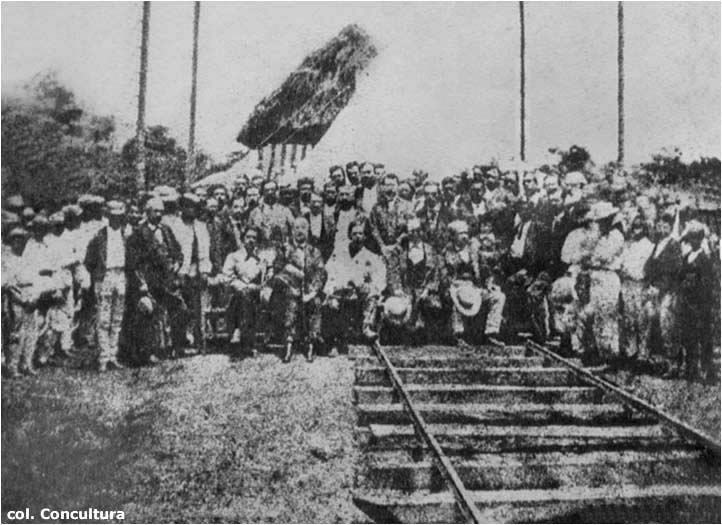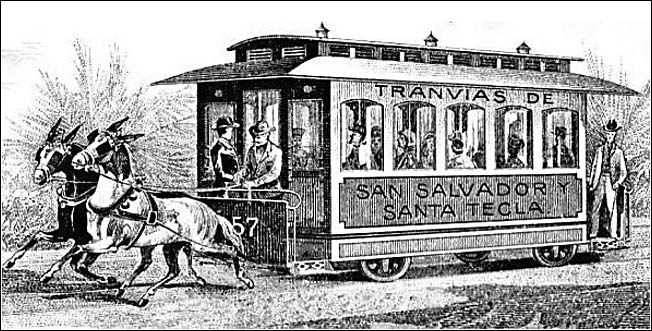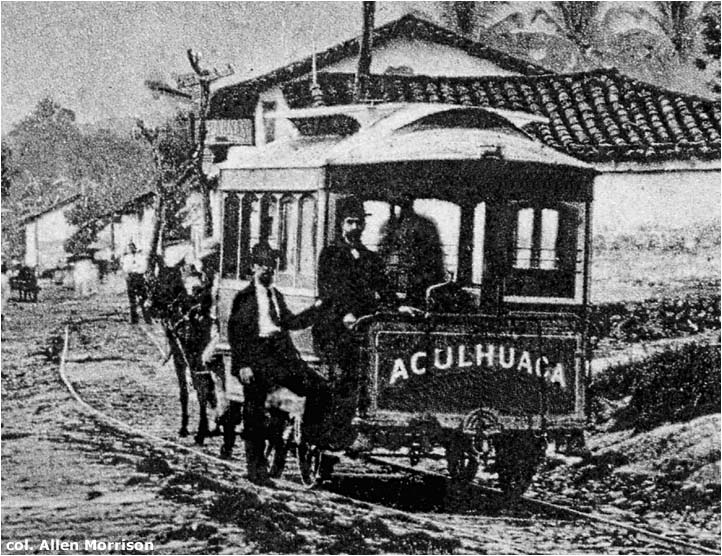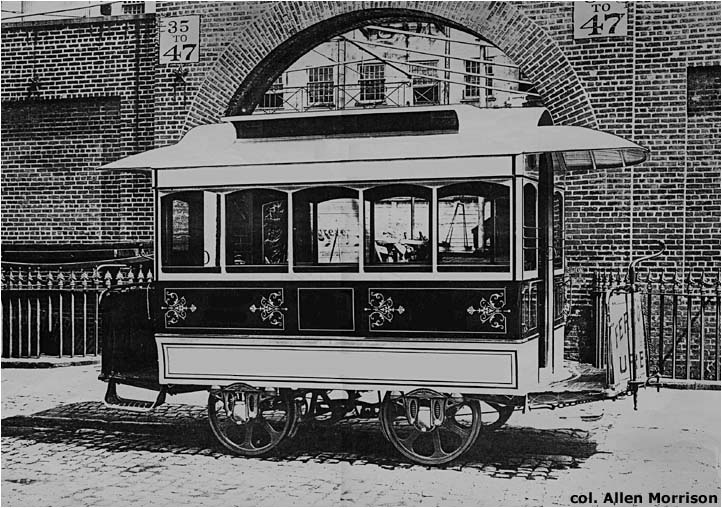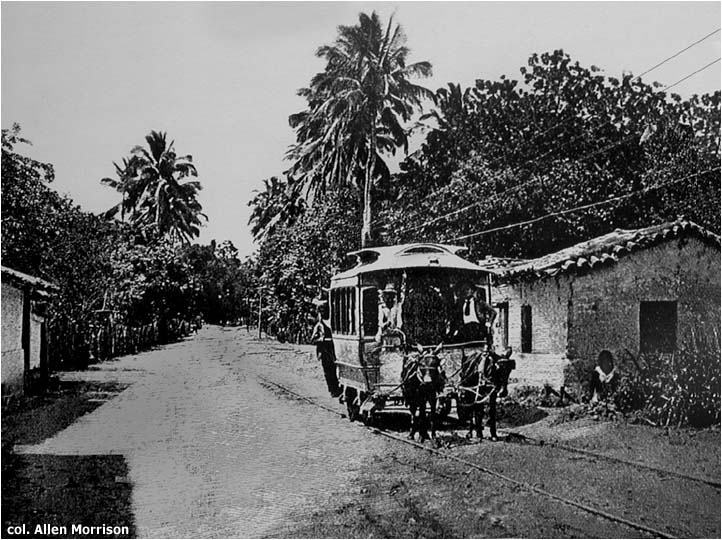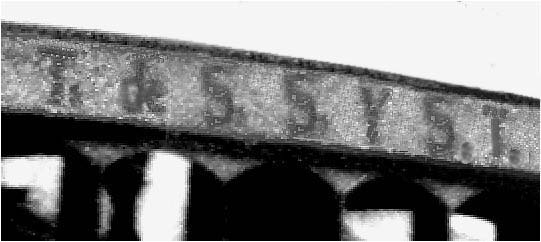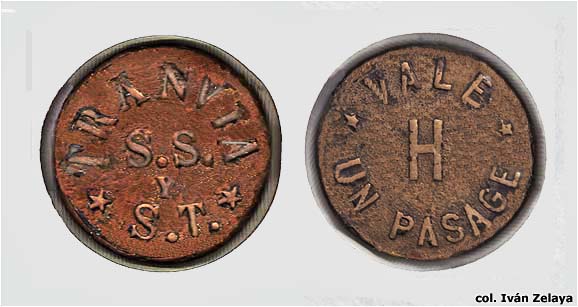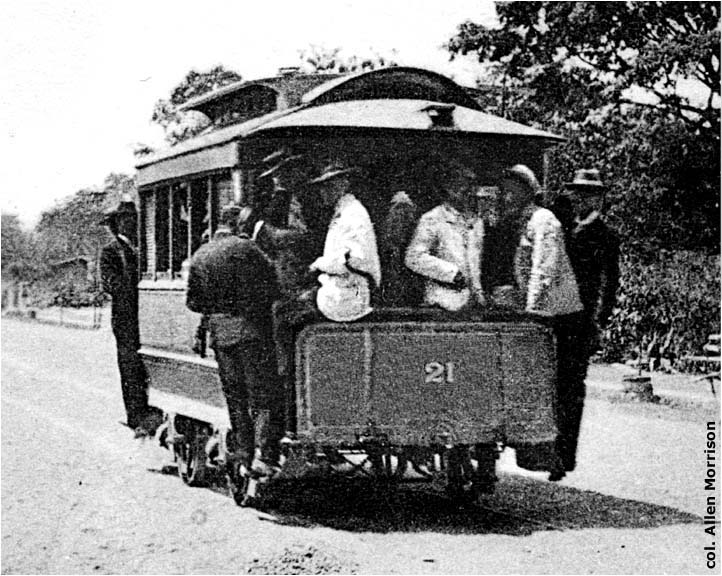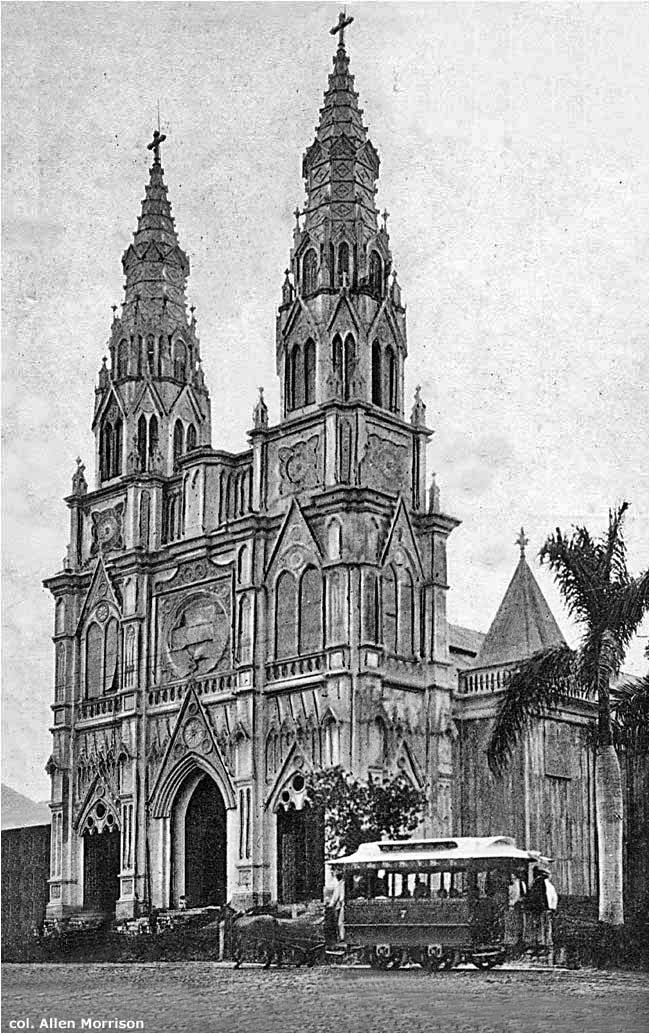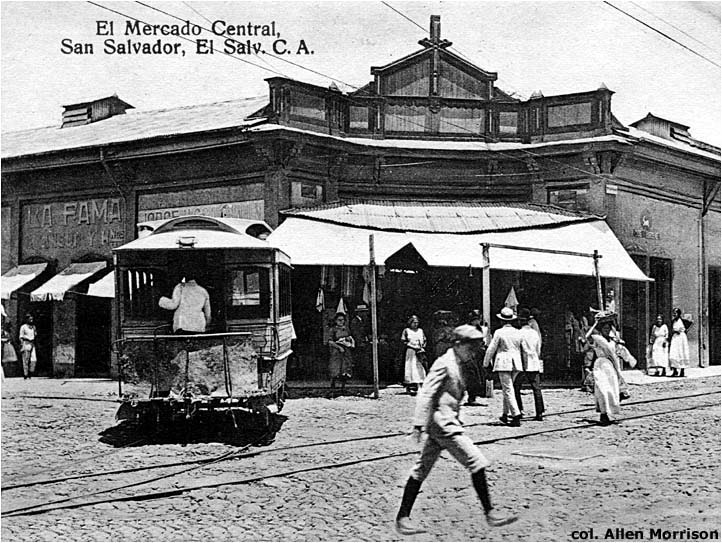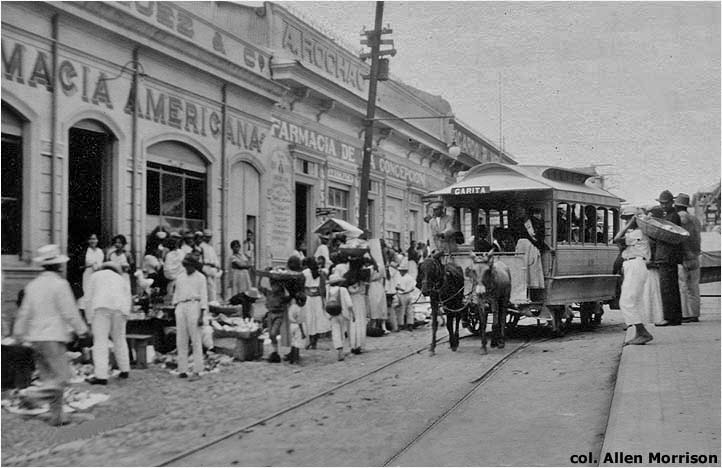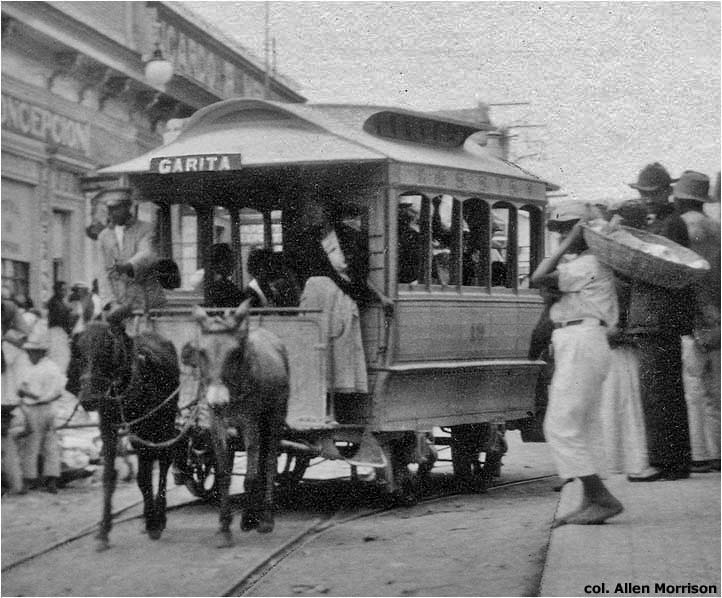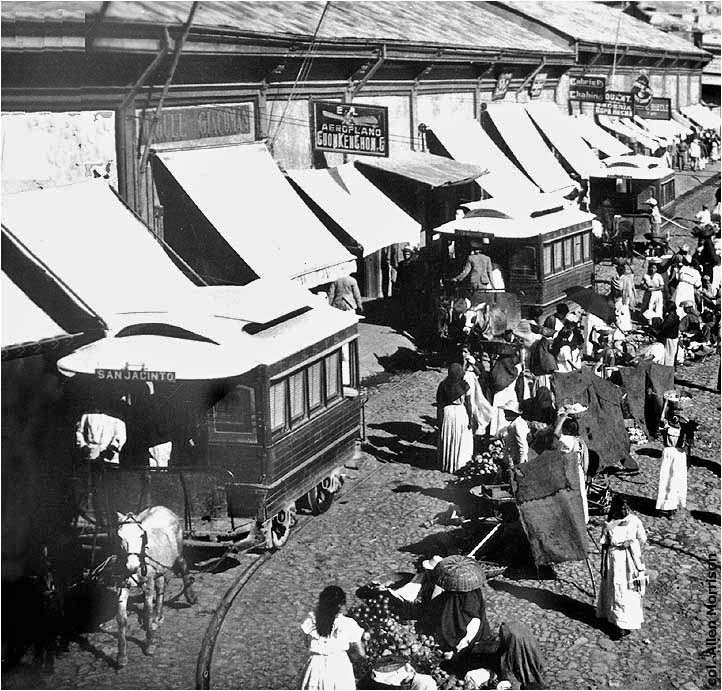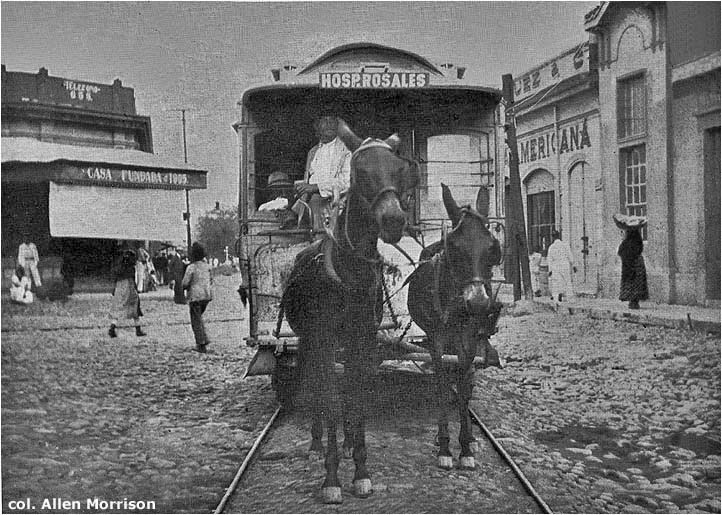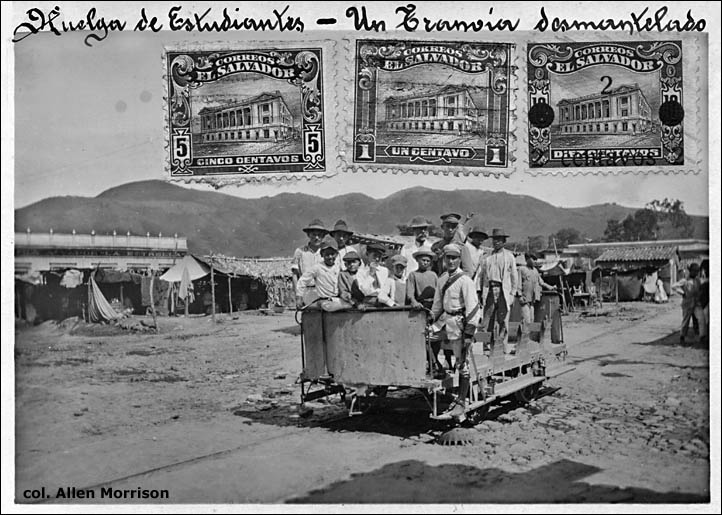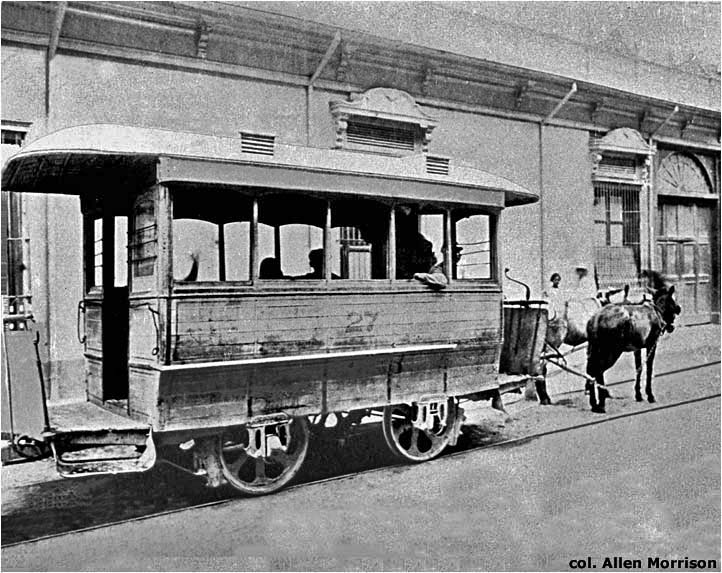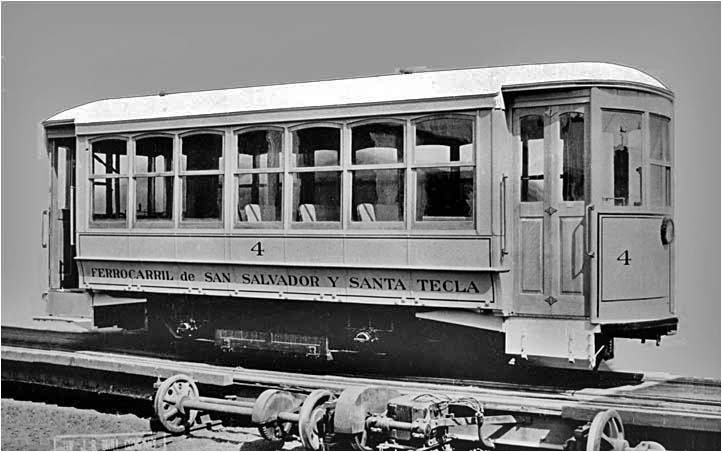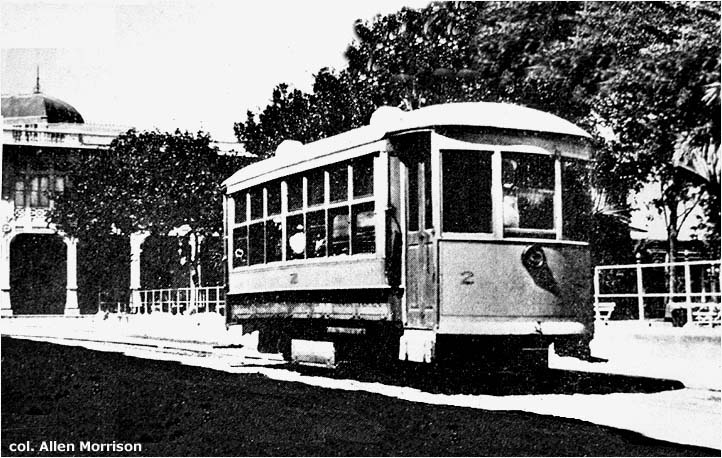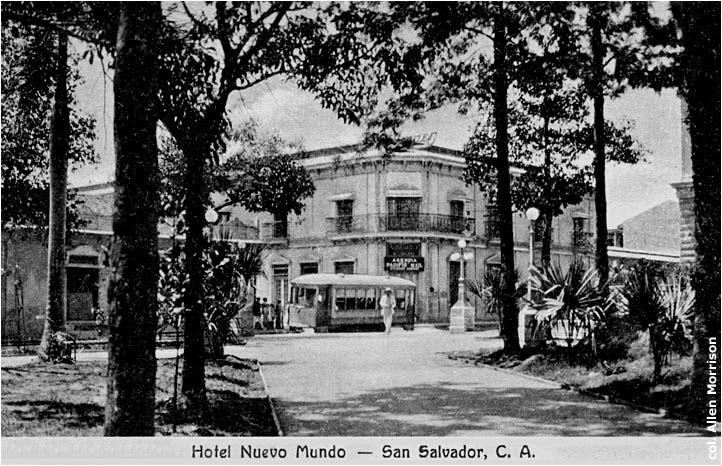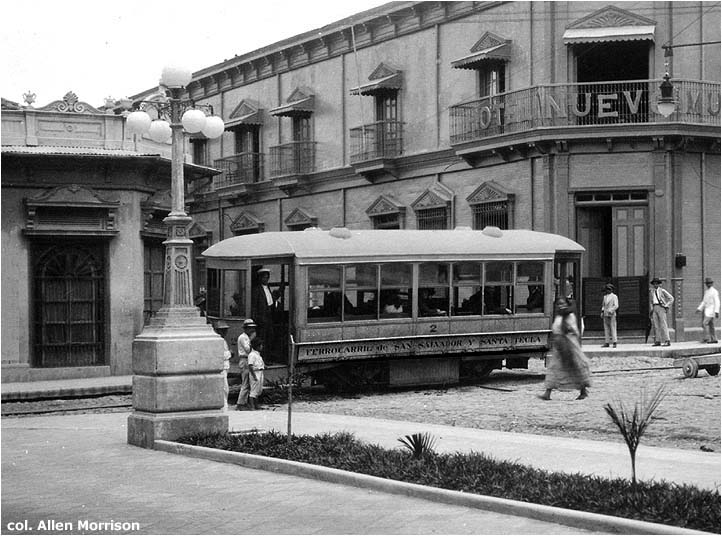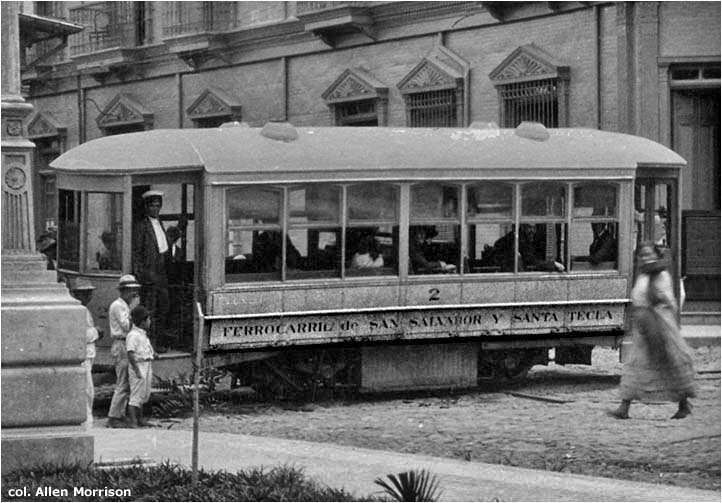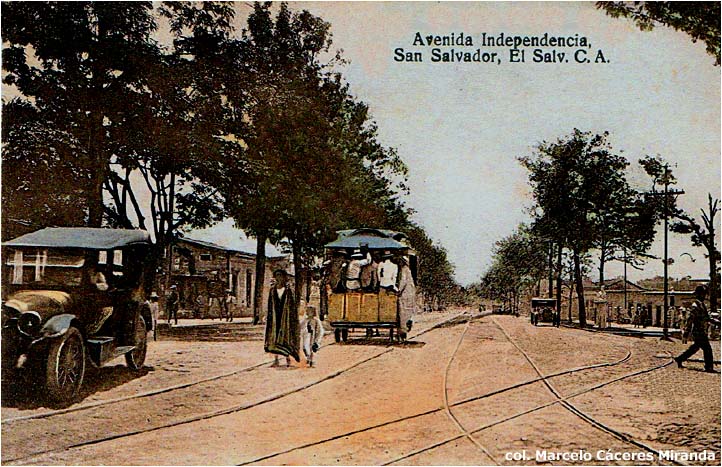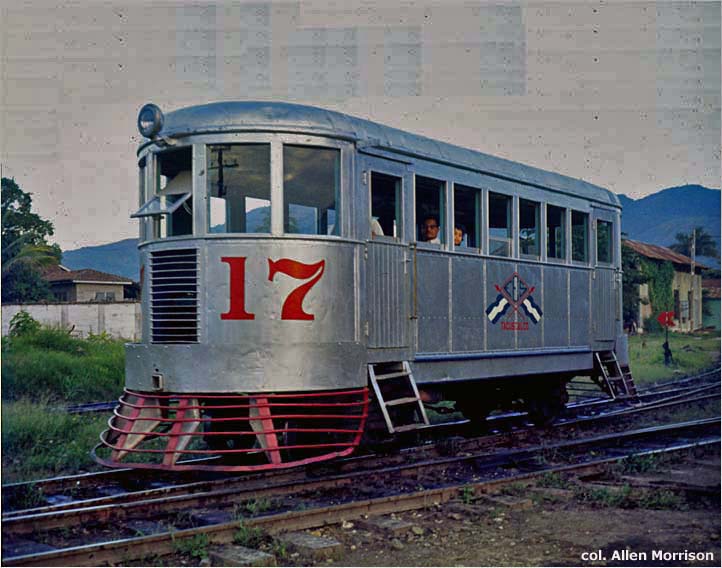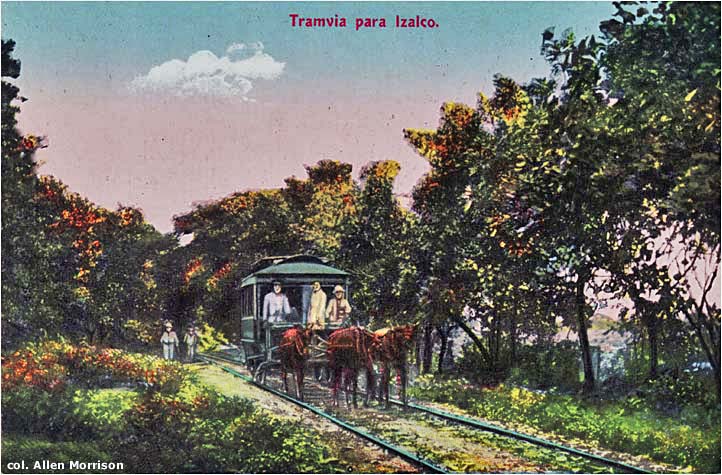The Tramways of
EL SALVADOR
BY Allen Morrison
The Republic of El Salvador is the smallest and most densely populated country in Central America and one of two (the other is Belize) that does not have both Pacific and Atlantic coasts [see map]. With an area of 8,124 square miles, it is about the size (and shape) of New Jersey in the United States. Most of El Salvador's eight million residents live on a central plateau which is surrounded by mountains and volcanoes. The country has been ravaged by earthquakes throughout its history. A quarter of the population lives in its capital, San Salvador. El Salvador's first railway was an 8-mile-long animal-powered line between San Salvador and Santa Tecla (sometimes called Nueva San Salvador) which opened on 26 July 1876 [see map].
(1) San Salvador - Santa Tecla President Santiago González awarded a contract in 1872 to a Prussian-born French engineer named Jean-Louis Bueron (Büron) to build railways to connect the country's chief ports: Acajutla, La Unión and La Libertad [see map and text by Lindo-Fuentes]. Bueron began with the San Salvador-Santa Tecla section of the route planned to La Libertad and laid the first railway track in El Salvador on 24 June 1873 [see García]. The rare photograph below shows President Santiago González at the dedication. The man in the center with his foot on the rail is probably Juan Luis Bueron [col. Consejo Nacional para la Cultura y el Arte]:
El Salvador's Gaceta Oficial of 27 July 1876 [quoted by García] reported the inauguration the previous day: the first horsedrawn tren from Santa Tecla, driven by Bueron, was greeted by President González and a large crowd on its arrival at Santa Lucia Gate in the capital. (Pector claims that the line was finished and inaugurated in 1873, but that the cars ran only to El Arenal [see map].) Salvadorans claimed the fourth railway in Central America – preceded only by the Panama Railroad and short lines in Costa Rica and Honduras. Bueron announced that starting 27 July the wagones would leave Santa Tecla every day at 7, 11 and 3:30, and San Salvador at 8:15, 12:15 and 7 [see García]. The 13 and 22 August editions of the Gaceta Oficial reported heavy loads on the tram cars and confidence that the line would soon reach La Libertad. It never did. Not much is known of the operation of Tranvías de San Salvador y Santa Tecla in the 1880s, except that service deteriorated. No picture of the cars, map of the line or other reports have been found. In 1894 a new company called Ferrocarril de San Salvador y Santa Tecla built a 3-foot gauge steam line along approximately the same route [see map], the tram line closed, and the Tranvías company built a new urban tram system in the capital. The Belgian historian says that Ferrocarril Urbano del Salvador opened its first line in 1894 and the company restored its original name, Tranvías de San Salvador y Santa Tecla, in 1899 [see Pector]. The illustration below is from an undated stock certificate. The tram didn't necessarily look like this:
|
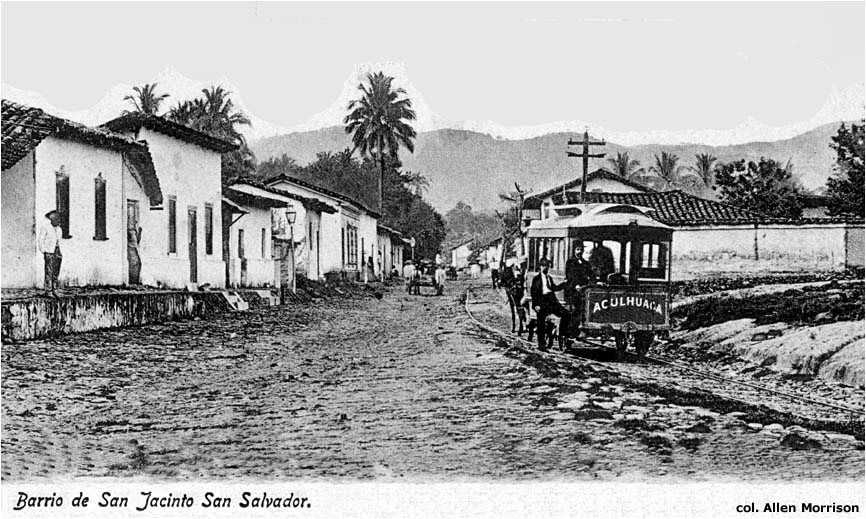
Detail of the image above [col. AM]:
Here is a photograph taken at the Stephenson factory in New York which shows the type of tram that it built in the 1870s. It is the same type tram shown above and in other San Salvador (and Sonsonate) views on this page [col. AM]:
The postcard view below seems to show a tram terminus – perhaps at Mejicanos or Aculhuaca [see map]. Note the very wide track gauge – similar to that shown in the first picture on this page. Apparently T. de S. S. y S. T. laid the rails of its urban system to accommodate the cars of its existing fleet [col. AM]:
The inscription that was still legible in the 1920s on some of the trams in San Salvador [col. AM]:
Here is one of the tokens used by the animal tramway ("vale un pasage" = good for one fare). The period when it was used is unknown, but it was before 1925 when the tramway closed [col. Iván Zelaya]:
The presence of the initials, of course, on either the vehicles or the tokens, is not proof that Tranvía(s de) San Salvador y Santa Tecla was always the name of the operator. A 1908 Bulletin of the International Bureau of American Republics speaks of a new tramway line in San Salvador whose tracks "parallel those of the Concepcion and Western Tramway". Was Tranvías de Concepción y Occidental the new name of the old company? What was the "new tramway line"? Avenida Independencia, shown in the postcard view below, led to the Estación Occidental on the east side of town [see map]. It was called Occidental because the steam trains of the Ferrocarril de El Salvador, which finally reached San Salvador in March 1900, traveled north and then west to the western parts of the country [see map] [col. AM]:
Closeup of the vehicle above. Most of the trams shown on picture postcards produced in the 20th century are numbered in the 15-30 range, so it is presumed that the company owned about 30 cars [col. AM]:
Tram 7 below is about to pass the Basílica del Sagrado Corazón on Calle Arce at 13a Avenida Sur [see map]. The operator's initials, "T. de S. S. Y S. T.", are visible again. This postcard was mailed in 1925 [col. AM]:
A tramway junction in downtown San Salvador [see map] [col. AM]
The photograph below, dated 19 December 1922, was taken on Calle Rubén Dario at 1a Avenida Norte [see map]. The condition of the tram seems too good – compare the vehicle in the previous illustration – for it to be 46 years old. Either it was built more recently or was an old car rebuilt. Or maybe it was a special car that was saved for special occasions [col. AM]:
Detail of the image above. The car is numbered 19. Note the initials "T. de S. S. Y S. T." above the windows. Classic Stephenson design. "Garita" = tram depot [col. AM]:
Another view of the Mercado on 1a Av. S. (South 1st Avenue) [see map]. In the 1920s all tram routes passed this point. Company initials are very legible on these cars. The sign "El Aeroplano CuonKenChon y Cía" is also intriguing [postcard, col. AM]:
According to the Pector report already quoted, the first tram line in San Salvador in 1894 ran from Rosales Hospital to the slaughter house via calles Bolívar, Las Casas and Franklin [see map] [postcard, col. AM]:
Who can explain the picture below? "Student Strike - A Dismantled Tram"! This postcard was mailed in April 1920. Before its top part was removed, the tram seems to have been an open cross-bench model. But no such trams are known to have run in San Salvador. Note tram track (and possibly a tram) on the street in the stamp [col. AM]:
There was a plan to electrify the San Salvador tramway system in 1913. Electric trams had run in nearby San José, Costa Rica, since 1899, in Panama City even longer, and there were already a dozen electric tramway systems in Mexico. But the World War intervened and nothing was done. By the 1920s most of San Salvador's 50-year-old trams were in poor condition. The photograph below was taken in 1925. The running gear and car body are original, but the roof has been reconstructed without the clerestory [col. AM]:
On 12 September 1919 the Ferrocarril de San Salvador y Santa Tecla – the narrow-gauge steam railroad that had replaced the wide-gauge tram line – ordered four battery-powered trams from J. G. Brill Company in Philadelphia. The photograph below was taken at the factory before shipment. The four cars were placed in service on 15 October 1920 on the steam railroad line, supplementing the steam trains that continued to run. In Santa Tecla the battery trams went beyond the station: they turned north onto new track on Av. Manuel Gallardo and ran three blocks to Parque Daniel Hernández [see map] [col. AM]:
This postcard shows battery tram 2 on 4a Av. S. (S. 4th Av.) next to Parque (or Plaza) Libertad in San Salvador [the little "4" on the map]. This was the original terminus of the F. de S. S. y S. T. battery tram service from Santa Tecla. The structure in the background is the Portal La Dalia, which still stands today. The car's batteries are in the compartment just above the rails [col. AM]:
In March 1923 the F. de S. S. y S. T. established a new battery tram service between its station on Calle Gerardo Barrios and Estación Occidental on Av. Independencia, the terminus of the Ferrocarril de El Salvador [see map and Pan American Union Bulletin]. The photographer who took this postcard view was standing in Plaza Barrios [col. AM]:
There was a plan in 1924 to replace the battery trams on both the San Salvador urban service and the Santa Tecla interurban line with electric trams using overhead wires. But the plan was not carried out. Here is another view of a battery tram in front of the Hotel Nuevo Mundo on 4a Calle Poniente (West 4th Street) [see map]. [col. AM]:
Enlargement of the previous view. Note battery compartment [col. AM]:
To capture the scene below, the photographer faced eastward at the junction of Calle Concepción and 1a Calle Oriente [East 1st Street], where Av. Independencia begins [see map]. The tram is headed for Estación Occidental in the distance – and is traveling left-hand, English-style! Note the automobile approaching on the right. Also note the narrow-gauge track crossing in the foreground – for the battery trams of the F. de S. S. y S. T. [postcard, col. Marcelo Cáceres Miranda]:
In 1925 San Salvador initiated a street paving program that doomed its tramway lines. The last horsecar is believed to have run that year (the exact date could not be found). The battery trams continued to run from the F. de S. S. y S. T. station on Calle Gerardo Barrios to Santa Tecla until 1929, when that railroad was dismantled and replaced by a highway. Both the old tram route and the railroad route are buried under the Pan-American Highway today [see map]. The Ferrocarril de El Salvador / Salvador Railway continued to carry passengers until 2002. In the 1960s, in addition to its steam- and diesel-powered trains, it operated a fleet of tram-like gasoline-powered railcars called balas de plata (silver bullets) in the San Salvador area and between Acajutla and Sonsonate. The specimen below was photographed in San Salvador in 1968. F. E. S./S. R. track gauge was 36 inches, same as that of the F.deS.S.yS.T. [col. AM]:
Recently, Ferrocarriles Nacionales de El Salvador established a daily train between San Salvador and Apopa 20 km north of the capital [see FENADESAL]. But aside from that, the only railway in San Salvador today is the "tranvía" – alas, the old word has lost its meaning – that circulates inside a small amusement park called Parque Infantil, on Alameda Juan Pablo II on the north side of town [see map]. The tramways of San Salvador are difficult to research. There is no one alive today who saw the 1876 interurban line, which closed in the 1890s, and it was unknown to most historians. The urban horsecar system was poorly recorded – the author could not find data on opening or closing dates, fleet size, routes, system length or track gauge. Most histories of the city make no mention of the tramway. Most of the buildings shown in postcard views have been destroyed by earthquakes and locations are difficult to identify. The city's streets have been renamed repeatedly and it is rare that two maps agree. There have been at least two numbering systems – 13th Avenue in 1921 is 5th Avenue today, etc. – and it is often unclear which one a text refers to. The description of the 1876 inauguration quoted by García says that a crowd gathered at "el portal de Santa Lucía" – but no map shows that place, none of the histories or historians consulted knows where it was, and therefore the author cannot determine with certainty the route of that pioneering intercity horse-powered line, which was one of the first of its kind in the world.
(2) Sonsonate - Izalco Sonsonate, a small city (2000 population: 70,000) about 40 miles west of San Salvador, was the terminus of the first steam-powered railroad in El Salvador, a 12-mile line connecting the port of Acajutla, which opened in 1882 [see map]. A franchise for a 6-mile animal-powered tram line to nearby Izalco (population also 70,000) was issued in 1892. It opened in 1894. The tramway climbed 900 feet between the two towns, and on the descent, at a steep section near Izalco, the horses were unhitched and the trams coasted down. This procedure attracted tourists and young boys from all over and the line continued operation until 1947. The car shown on this postcard view is of the same Stephenson type used by Tranvías de San Salvador y Santa Tecla, and was probably acquired from that line when it reorganized in the 1890s [see above]. In 1947 it would have been 72 years old [col. AM]:
In his list of "Existing Tramways" Pector notes the formation of the Compañía de los Tranvías de Santa Ana y La Laguna" in 1895. But no evidence could be found that a tramway ever existed in Santa Ana, which is about 50 miles northwest of San Salvador [see map].
BIBLIOGRAPHY Joseph Laferrière. De Paris à Guatémala: notes de voyages au Centre-Amérique, 1866-1875. Paris, 1877. Early trip reports. Laferrière visited El Salvador in 1866, 1870 and 1874-1875 and observed the construction of the San Salvador - Santa Tecla tramway before it opened. See sample texts. Poor's Manual of Railroads, 1868-1924. New York, 1869-1924. During the 1880s and 1890s several (but not all) editions of this annual survey reported data and finances of the railways of El Salvador, including the Santa Tecla line. Unfortunately they do not say very much. See 1889 entry. Mirna Evelyn Delgado. Geografía Elemental de la República del Salvador. Paris: 1890 (reproduced by Guillermo J. Dawson, San Salvador, 1996). Geography lessons in question-and-answer form. The answer to question 20 on page 39, about existing railroads in San Salvador department, is: "Only the tramway from the capital to Santa Tecla." "El Salvador. Ministerio de Hacienda y Crédito Público. Memoria, 1907. San Salvador, 1908. A chart labeled "Franquicias aduaneras de 1907" on p. 127 notes the "Tranvías San Salvador y Santa Tecla". This is one of the few places where the author has seen that name printed in full. International Bureau of the American Republics. Bulletin, 7-12/1908. Washington, 1908. Report on pp. 944-945 of a new tramway line in San Salvador. Percy F. Martin. Salvador of the Twentieth Century. London, 1911. Brief tramway description on p. 260 was based on the IBAR report above: "There are two companies running regular services of cars, one being the Concepcion and Western Tramway Company, which sends out its cars at intervals of ten minutes during the busiest parts of the day." D. Pector. "Les Chemins de Fer Sud-Américains: Salvador" in Revue Économique Internationale (Brussels), 7/1913, pp. 98-123. Extraordinary. The most comprehensive survey that was found of tramway development in El Salvador. Nice sections on the Chemin de fer de Santa Tecla, p. 110, the Tramways existants, p. 121, and the origins of the Ferrocarril Urbano del Salvador, p. 122. C. Alvarado C. "Plano de la Ciudad de Sn. Salvador – Elaborado según los datos obtenidos de los planos del Ing. Roberto Gayol y el del Estado Mayor Central del Ejército". Escala 1:4000, San Salvador, 1921. Beautiful large street map showing tram lines, including the route of the "Electric (storage battery) car line to Santa Tecla" [those words written in English on the map]. Pan American Union. Bulletin, April 1923. Washington, 1923. News item about the inauguration of battery tram service on the streets of San Salvador. "Trolley System as Auxiliary in Salvador" in Electric Railway Journal (New York), 15 December 1923, p. 1027. Announcement that the battery-powered trams that connect the two railway stations will be replaced by electric cars using overhead wire. W. Rodney Long. "Salvador" in U.S. Bureau of Foreign and Domestic Commerce: Trade Promotion Series #5 (1925), pp. 51-53. Detailed description of the San Salvador & Santa Tecla Railway. Text contradicts the ERJ article noted previously: it is the interurban railway that will be electrified; the battery cars will serve the urban line. (In fact, neither line was ever electrified with overhead wire.) Miguel Angel García. Diccionario Histórico Enciclopédico de la República de El Salvador. Tomo II, San Salvador, 1954. The author quotes the description in the Gaceta Oficial of 27/7/1876 of the inauguration the previous day of the new railway between San Salvador and Santa Tecla: Ferrocarril de Sangre. He also cites a timetable for the service and texts describing the line's construction. Gerald M. Best. Central American Holiday. Redwood City (California), 1960. A brief illustrated survey of the Salvador Railway, pp. 7-11. Steam railroad background. Nothing on trams. Julio C. Castro. Estampas del Viejo San Salvador. San Salvador, 1978. "El Ferrocarril entre San Salvador y Santa Tecla" on pp. 67-70 describes the steam line opened in 1894, and its later battery trams. There is no mention of the earlier horsedrawn railway. However, there are pictures of San Salvador horsecars on pp. 9, 35, 70 and 71. Héctor Lindo-Fuentes. Weak Foundations: The Economy of El Salvador in the Nineteenth Century. Berkeley, 1990. A magnificent work, which can be read in full, including notes, online. A concise but valuable railroad survey describes Bueron's work on the 1876 tramway. Stephen Grant. Postales Salvadoreñas del Ayer/Early Salvadoran Postcards, 1900-1950. San Salvador, 1999. "Tranvía para Izalco/Tramway at Izalco, c1920" provides a nice bilingual description of the tramway and the postcard reproduced on this page. Delmer G. Ross. Development of Railroads in Guatemala and El Salvador, 1849-1929. Lewiston (NY), 2001. Scholarly investigation of the subject. The discussion of the construction of the steam railway between San Salvador and Santa Tecla, p. 102, says that it will "follow the route of an already existing and sporadically operating horse railroad". There is a brief synopsis of El Salvador's tramways on pp. 175-176. Reynaldo Galindo Pohl. Recuerdos de Sonsonate: crónica del 32. San Salvador, 2001. "El tranvía de Mulas entre Izalco y Sonsonate", p. 137. Nice description of and tribute to the tram line. But no dates or other data. América Rodríguez Herrera. San Salvador: historia urbana, 1900-1940. San Salvador, 2002. This book is cited only because of the fact that, despite its title, it makes no mention of tramways – or urban transport at all! That's not a very good "urban history", señor. Ernesto Rivas Gallont. La Historia y los Cuentos de La Ciudad de Las Colinas. Santa Tecla, nd [2003?]: free downloadable PDF. "El ferrocarril, el tranvía eléctrico y su precursor", pp. 175-177. Mostly about the steam railway that opened in 1894, but there's a brief mention of the 1876 interurban horsedrawn line. Good information about the railway stations and the battery tram service. Daysi Carolina Amaya. "Tranvía citadino" in Hablemos On line of 13 VII 2003. Brief description of the San Salvador tram routes. Juan José Contreras, Callejas, Mauricio Alvarado Cea Campo, Ángela Margarita Alvarado. Santa Tecla: Cronología. San Salvador, 2004. "El Ferrocarril de Santa Tecla", pp. 60-62, distinguishes clearly between the first railway of 1876 and the second one opened in 1894 – which it says closed in 1929. Quotes the same Gaceta Oficial passage quoted by García in 1954 [see above]. Pictures of the steam railway station in Santa Tecla and the battery tram – but not of the first railway line. Óscar Monedero Alfaro. Una familia con un gran legado" in Hablemos On line of 5 IX 2004. This brief history of the Duke family of North Carolina and Santa Tecla mentions, in the last paragraph, that Mauricio Duke Alexander originated and owned the tranvía eléctrico San Salvador-Santa Tecla. Carlos Alberto Chávez. "Las volcaneñas, entre lo sublime y lo folclórico" in laprensagráfica.com of 7 I 2007. Exploring the origin of local roads, some of which were built to avoid volcanos, the author states: ". . . desde 1876 existió una línea de 'tranvías de sangre (tracción animal)” que unía a San Salvador con Santa Tecla" [since 1876 there was an animal-drawn tram route that connected San Salvador with Santa Tecla]. Ernesto Rivas Gallont. "El Transporte en la Historia" in Conversaciones con Netorivas (his blog), 1 June 2008. A fine transport survey which expands this author's text originally published in his undated (2003?) La Historia y los Cuentos de La Ciudad de Las Colinas [see above]. Ernesto Rivas Gallont. "Los Ferrocarriles en El Salvador, Una Pesada Carga Histórica" in Conversaciones con NetoRivas (his blog), 19 August 2009. An excellent general survey of railroad development in El Salvador.
See my index of If you have comments, criticism or additional information, This site was placed online on Copyright © 2009-2109 Allen Morrison |
